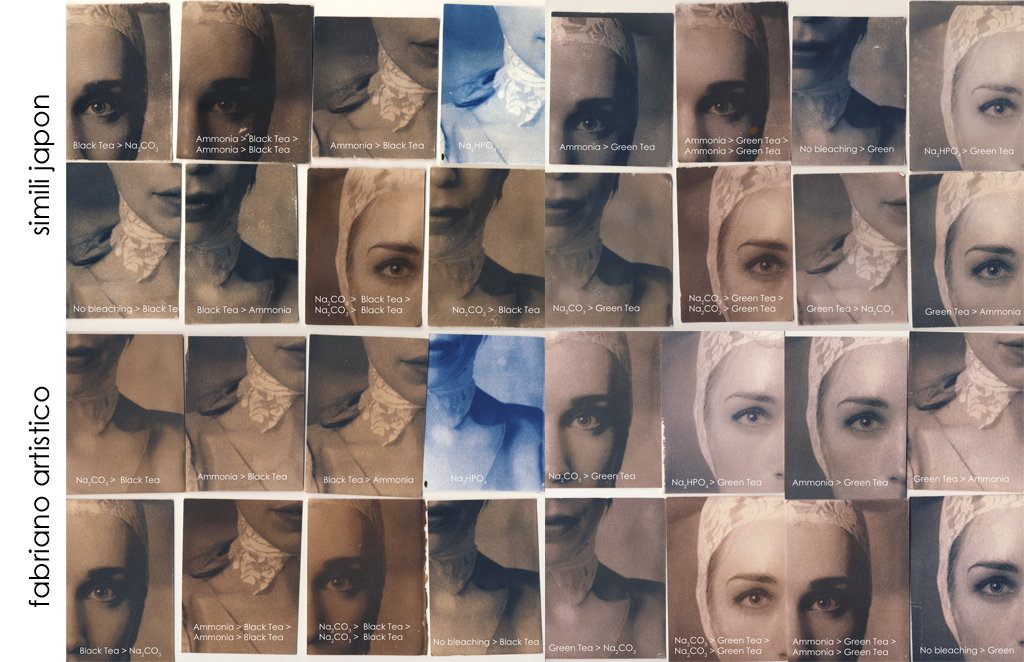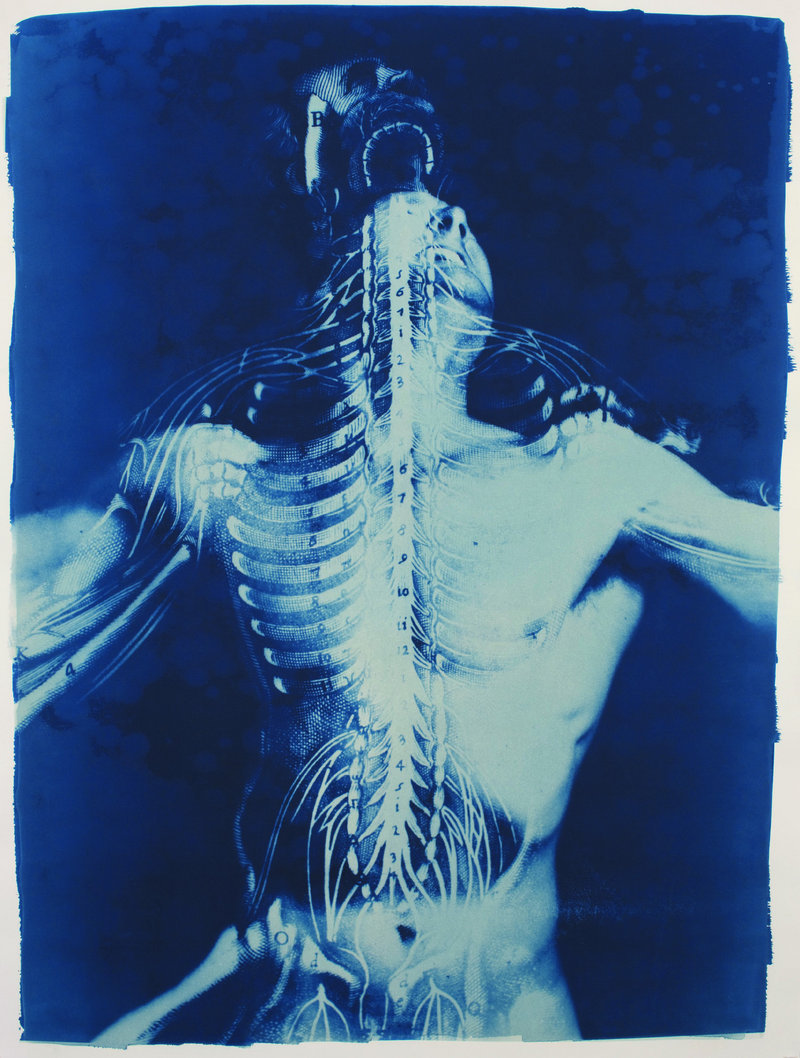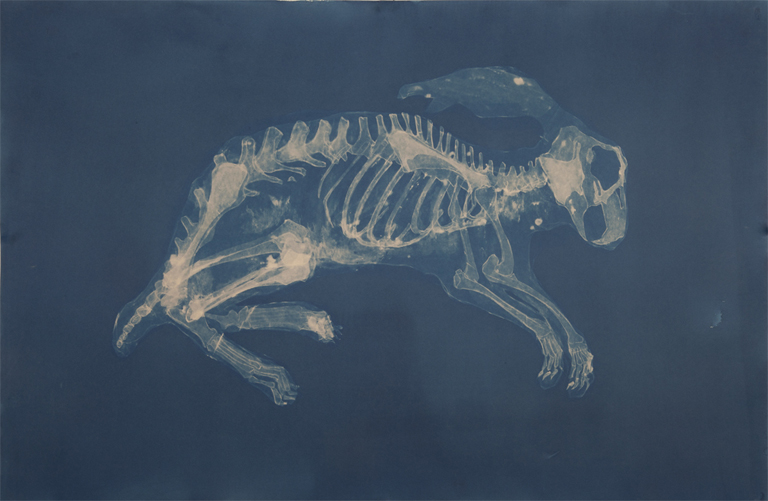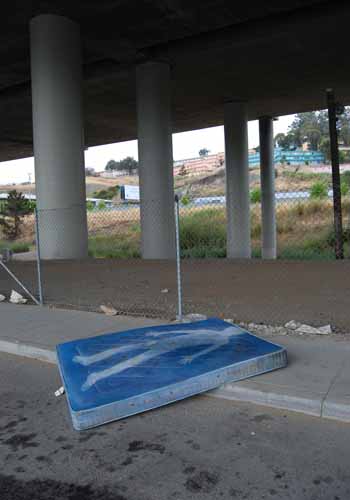Cyanotype mixing instructions. They call it the 'Classic Cyanotype' process. That's accurate. It's simple and only requires two relatively benign chemicals. The 'New Cyanotype' process requires the use of a more dangerous chemical, so we aren't going that route, nor is it necessary to do so are we will be making our own digital negatives allowing us to control contrast that route.
This is the recipe that we will be using through out the course.
You apply the curves to the image (if necessary), then turn it into a negative by inverting it. Then you print it out on transparency.
Expose Notes:
It is better to over expose your prints and then bleach them down as opposed to trying to get the exact times (especially true if you are exposing in the sun).
SURVEY OF EXPOSURE TIMES - should provide a good jumping off point.
Some papers that have been recommended for cyanotypes by knowledgeable folks:
Canson Montval watercolor
Arches Platine
Fabriano Artistico
Lana
Arches Acquarelle
Saunder’s Waterford
Somerset Book
Crane’s Platinotype.
Reading homework:
Read Chapter 10 of the Robert Hirsch's book Photographic possibilities : the expressive use of equipment, ideas, materials, and processes The book is available for free in its entiretly via UM's online library offerings. If the direct link above doesn't work, do a search in Miryln for it and it will pop up.
Excellent excerpt on Cyanotype from Christopher James' book on Alternative Processes. It includes a nice section on toning cyanotypes. I suggest you read the entire Chapter/PDF.
Great thread on toning cyanotypes using a sodium bicarbonate 'bleaching' phase before soaking the print in a tannin rich solution of tea of coffee.
Excellent discussion of toning cyanotypes. Really excellent. Be sure to read it as it goes over what kind of results you can expect from the various toners and methodologies.
Below is an excellent image by Simili Japon illustrating the affects of multiple different toners on Cyanotype prints.
Artists working with Cyanotype (somewhat random selection)
Ginger Owen-Murakami makes cyanotypes on newsprint and other media.
Nice series of toned Cyanotype prints by Emma Powell.
Video in which the artist tones cyanotype prints using TSP (branded name of a common cleaner made of Trisodium Phosphate) to 'bleach' the cyanotype before soaking the print in tea.
PDF of the instructions of the Cyanotype solution that we are using.
How to make a digital step Wedge
Nice write up on how to make a cyanotype using a digital negative
Alternative Photography article on sizing paper which includes instructions on how to size paper using arrowroot starch.
Another write up on the process of creating a digital negative
Nice write up on the entire process of making the digital negative, mixing the chems, and making the final print.
iPhone to Cyanotype
Sunday, February 23, 2014
Cyanotype
Update 3/5
Cyanotype mixing instructions. They call it the 'Classic Cyanotype' process. That's accurate. It's simple and only requires two relatively benign chemicals. The 'New Cyanotype' process requires the use of a more dangerous chemical, so we aren't going that route, nor is it necessary to do so are we will be making our own digital negatives allowing us to control contrast that route.
This is the recipe that we will be using through out the course.
You apply the curves to the image (if necessary), then turn it into a negative by inverting it. Then you print it out on transparency.
Expose Notes:
It is better to over expose your prints and then bleach them down as opposed to trying to get the exact times (especially true if you are exposing in the sun).
SURVEY OF EXPOSURE TIMES - should provide a good jumping off point.
Some papers that have been recommended for cyanotypes by knowledgeable folks:
Canson Montval watercolor
Arches Platine
Fabriano Artistico
Lana
Arches Acquarelle
Saunder’s Waterford
Somerset Book
Crane’s Platinotype.
Reading homework:
Read Chapter 10 of the Robert Hirsch's book Photographic possibilities : the expressive use of equipment, ideas, materials, and processes The book is available for free in its entiretly via UM's online library offerings. If the direct link above doesn't work, do a search in Miryln for it and it will pop up.
Excellent excerpt on Cyanotype from Christopher James' book on Alternative Processes. It includes a nice section on toning cyanotypes. I suggest you read the entire Chapter/PDF.
Great thread on toning cyanotypes using a sodium bicarbonate 'bleaching' phase before soaking the print in a tannin rich solution of tea of coffee.
Excellent discussion of toning cyanotypes. Really excellent. Be sure to read it as it goes over what kind of results you can expect from the various toners and methodologies.
Below is an excellent image by Simili Japon illustrating the affects of multiple different toners on Cyanotype prints.
Another artist who made a similar 'ring a round' of toned cyanotypes. Visit his blog to see what's what.
Artists working with Cyanotype (my attempt is to show you a broad range of ways in which contemporaty artists are working with Cyanotypes)
Ginger Owen-Murakami prints cyanotypes on newsprint and combines them with other media.

Nice series of toned Cyanotype prints by Emma Powell.
Robin Hill incorporates large scale Cyanotypes into installations.
Christian Marclay - MOMA bought one of his pieces in 2008 and had some of his work on display in 2012-2013
Christian Marclay - Cyanotypes from JRP|Ringier on Vimeo.
Thomas Hager
Gray Lyons - large scale Cyanotypes
Tasha Lewis prints onto cloth and makes sculptures from them.
Traci Marie Lee
Carrie Witherell
Robert Rauschenberg - yes, that Robert Rauschenberg
BlueOnWhite - Tumblr site with a great variety of cyanotypes
Video in which the artist tones cyanotype prints using TSP (branded name of a common cleaner made of Trisodium Phosphate) to 'bleach' the cyanotype before soaking the print in tea.
Nice video by Scott Barnes on the process. He uses a test strip to determine the exposure for the prints. Interesting technique.
PDF of the instructions of the Cyanotype solution that we are using.
How to make a digital step Wedge
Nice write up on how to make a cyanotype using a digital negative
Alternative Photography article on sizing paper which includes instructions on how to size paper using arrowroot starch.
Photographer's Formulary instructions for preparing Arrowroot Starch for Sizing:
Another write up on the process of creating a digital negative
Nice write up on the entire process of making the digital negative, mixing the chems, and making the final print.
iPhone to Cyanotype
Cyanotype tutorial on the Martha Stewart website. Funny.
This guy make cyanotype 'negatives' directly in camera. He is using pre-made stuff, but should work using homemade emulsions as well.
Apparently this guy makes glass Cyanotypes negatives. Here is a link to his homepage. He's very into historical and alternative photographic processes.
Cyanotype mixing instructions. They call it the 'Classic Cyanotype' process. That's accurate. It's simple and only requires two relatively benign chemicals. The 'New Cyanotype' process requires the use of a more dangerous chemical, so we aren't going that route, nor is it necessary to do so are we will be making our own digital negatives allowing us to control contrast that route.
This is the recipe that we will be using through out the course.
You apply the curves to the image (if necessary), then turn it into a negative by inverting it. Then you print it out on transparency.
Expose Notes:
It is better to over expose your prints and then bleach them down as opposed to trying to get the exact times (especially true if you are exposing in the sun).
SURVEY OF EXPOSURE TIMES - should provide a good jumping off point.
Some papers that have been recommended for cyanotypes by knowledgeable folks:
Canson Montval watercolor
Arches Platine
Fabriano Artistico
Lana
Arches Acquarelle
Saunder’s Waterford
Somerset Book
Crane’s Platinotype.
Reading homework:
Read Chapter 10 of the Robert Hirsch's book Photographic possibilities : the expressive use of equipment, ideas, materials, and processes The book is available for free in its entiretly via UM's online library offerings. If the direct link above doesn't work, do a search in Miryln for it and it will pop up.
Excellent excerpt on Cyanotype from Christopher James' book on Alternative Processes. It includes a nice section on toning cyanotypes. I suggest you read the entire Chapter/PDF.
Great thread on toning cyanotypes using a sodium bicarbonate 'bleaching' phase before soaking the print in a tannin rich solution of tea of coffee.
Excellent discussion of toning cyanotypes. Really excellent. Be sure to read it as it goes over what kind of results you can expect from the various toners and methodologies.
Below is an excellent image by Simili Japon illustrating the affects of multiple different toners on Cyanotype prints.
Another artist who made a similar 'ring a round' of toned cyanotypes. Visit his blog to see what's what.
Artists working with Cyanotype (my attempt is to show you a broad range of ways in which contemporaty artists are working with Cyanotypes)
Ginger Owen-Murakami prints cyanotypes on newsprint and combines them with other media.

Nice series of toned Cyanotype prints by Emma Powell.
Robin Hill incorporates large scale Cyanotypes into installations.
Christian Marclay - MOMA bought one of his pieces in 2008 and had some of his work on display in 2012-2013
Christian Marclay - Cyanotypes from JRP|Ringier on Vimeo.
Natalie Cheung
Thomas Hager
Anna Hepler
Miles McNulty - part of a very cool art project in which artist made works on abandoned ledgers and such form a former factory. From the site, "Much more than the usual bound version of a poetry chapbook, ampersand is a collection of poetry and visual art printed, drawn and written on the pages of invoices, bills, advertisements, checks, ledger sheets, folders, binders and every other kind of suitable surface found in files that had not seen light for 40 or 50 years since the building shut down as an industrial site."
Arturo Herrara - he was featured in an ART 21 segment. If you like distressing film and such, then you should really read up on him. His work appeared in MOMA. He is a kind of a big deal.Gray Lyons - large scale Cyanotypes
Tasha Lewis prints onto cloth and makes sculptures from them.
Traci Marie Lee
Carrie Witherell
Dustin Fosnot
Robert Rauschenberg - yes, that Robert Rauschenberg
making of the image
BlueOnWhite - Tumblr site with a great variety of cyanotypes
Video in which the artist tones cyanotype prints using TSP (branded name of a common cleaner made of Trisodium Phosphate) to 'bleach' the cyanotype before soaking the print in tea.
Nice video by Scott Barnes on the process. He uses a test strip to determine the exposure for the prints. Interesting technique.
PDF of the instructions of the Cyanotype solution that we are using.
How to make a digital step Wedge
Nice write up on how to make a cyanotype using a digital negative
Alternative Photography article on sizing paper which includes instructions on how to size paper using arrowroot starch.
Photographer's Formulary instructions for preparing Arrowroot Starch for Sizing:
Your kit contains 20g of arrowroot starch. Place this starch in a 1-liter container that you can heat (such as a sauce pan) and add a small amount of hot water (about 20 ml) Stir the mixture into a thick cream. Be sure that no lumps remain. Add 1 liter of hot water with constant stirring. Boil the mixture for 5 minutes, then let it cool to room temperature. Skim off any scum or decant the clear solution into a storage container.
Another write up on the process of creating a digital negative
Nice write up on the entire process of making the digital negative, mixing the chems, and making the final print.
iPhone to Cyanotype
Cyanotype tutorial on the Martha Stewart website. Funny.
This guy make cyanotype 'negatives' directly in camera. He is using pre-made stuff, but should work using homemade emulsions as well.
Apparently this guy makes glass Cyanotypes negatives. Here is a link to his homepage. He's very into historical and alternative photographic processes.
Wednesday, February 12, 2014
Assignment #2: The Exquisite Film (Will Drink the New Developer)
Assignment #2: The Exquisite Film (Will Drink the New Developer)
"The exquisite corpse will drink the new wine" - an early result of the exquisite corpse game from which the name derived
On the bridge the dew with the head of a tabby cat lulls itself to sleep. - ANDRÉ BRETON (he wrote the Surrealist Manifestos)
Excellent visual from Choreographic Color blog.
Here is an excellent gallery of Exquisite Corpse drawings.
After looking at a number of Exquisite Corpse images, it would seem clear that Dali was inspired by the results of the process. Soft Construction with Boiled Beans (Premonition of Civil War) 1936
From ArtArchive:
Andre Breton's phrase 'pure psychic automatism' was intended to apply to the process of writing and Breton even gave practical hints on how to do it. In 1930 he published his second Manifeste du surréalisme in which he defined 'surreality' as the reconciliation of the reality of dreams with the reality of everyday life into a higher synthesis.
Underlying the interest in automatism and dream lay the Surrealist notion of what was called 'objective chance'. They believed that the existence of coincidences (events for which there were no rational explanations) was evidence and that true reality was not ordered or logical. Access to reality could only be gained through the unconscious mind.
In the article Surrealism, Freud and Trotsky 'objective chance' is well described as "serendipitous and unpredictable moments when incongruous elements encountered in everyday life combine together to produce a kind of mystical insight, like in a waking dream."
This assignment, The Exquisite Film, is an exercise in objective chance.
To evoke that objective chance, you will shoot a roll of film that a classmate has already taken photos on. We will begin by anonymously exchanging a list of three words with a classmate. They can be any words that you want. Possibly emotions, subjects, events, scales, colors, shapes, etc. Once you have your word list, you are to go about shooting your roll of film. You should shoot approximately half your roll of film with some nod to the words as you choose to interpret them. The other roll of film is to be shot as you see fit. The only thing I ask is that there is some variety on the roll - please don't take a whole roll of film of your dog ;-)
You can use any camera that you want. It does have to be 35mm black and white film though. For example, if you have a toy camera such as a Fakenflex, you could use that, or you could shim it into a Holga and use that.
On Monday October 7th, you need to bring in your exposed roll of film. Do not write or mark on the canister in anyway. If you can safely rewind the film without rewinding the film lead back into the canister, then please do so as it will save me time from having to retrieve it using a special tool.
All the identical film will be placed into a box, shaken up, and then everyone will pull out a roll of film. That becomes your roll now. The person who originally shot the film loses all rights to it. The image become yours. Then go out and shoot over it. I encourage you to have a variety of images. Again, use whatever camera you want to. Whatever techniques you want to use.
Develop the film. It is likely that the frames don't overlap 'accurately'. Chose whatever length of film that you want to print. Make prints from the best three images. You will very likely have to do some crafty dodging and burning to make the image look its best.
2/12 Exchange word lists
2/19 Bring in exposed roll of film
2/26 Process the film (the sooner the better)
3/10 Second round if necessary/desired
3/19 Critique. Turn in the two prints and contact sheet.

"The exquisite corpse will drink the new wine" - an early result of the exquisite corpse game from which the name derived
On the bridge the dew with the head of a tabby cat lulls itself to sleep. - ANDRÉ BRETON (he wrote the Surrealist Manifestos)
Among Surrealist techniques exploiting the mystique of accident was a kind of collective collage of words or images called the cadavre exquis (exquisite corpse). Based on an old parlor game, it was played by several people, each of whom would write a phrase on a sheet of paper, fold the paper to conceal part of it, and pass it on to the next player for his contribution.
The technique got its name from results obtained in initial playing, "Le cadavre / exquis / boira / le vin / nouveau" (The exquisite corpse will drink the young wine). Other examples are: "The dormitory of friable little girls puts the odious box right" and "The Senegal oyster will eat the tricolor bread." These poetic fragments were felt to reveal what Nicolas Calas characterized as the "unconscious reality in the personality of the group" resulting from a process of what Ernst called "mental contagion."
At the same time, they represented the transposition of Lautréamont's classic verbal collage to a collective level, in effect fulfilling his injunction-- frequently cited in Surrealist texts--that "poetry must be made by all and not by one." It was natural that such oracular truths should be similarly sought through images, and the game was immediately adapted to drawing, producing a series of hybrids the first reproductions of which are to be found in No. 9-10 of La Révolution surrealiste (October, 1927) without identification of their creators. The game was adapted to the possibilities of drawing, and even collage, by assigning a section of a body to each player, though the Surrealist principle of metaphoric displacement led to images that only vaguely resembled the human form.
Source: "Dada & Surrealist Art," by William S. Rubin
This assignment is inspired by the Surrealist artistic practice/game of the Exquisite Corpse. Originally a written word game in which a sentence would be completed by multiple people, each unaware of what the earlier author wrote, the practice was quickly adopted to the visual arts. The common practice is to fold a piece of paper up and ask each person to draw onto one folded side. Some allow a small edge to remain visible when folded to facilitate the continuation of the previous artist's line. A more rigid interpretation of the Exquisite Corpse calls for one artist to draw a head, another to draw a torso, and lastly one to draw the lower body (or similar).Excellent visual from Choreographic Color blog.
Here is an excellent gallery of Exquisite Corpse drawings.
After looking at a number of Exquisite Corpse images, it would seem clear that Dali was inspired by the results of the process. Soft Construction with Boiled Beans (Premonition of Civil War) 1936
Contemporary Exquisite Corpse by Jake Chapman & Dinos Chapman, 2000
From ArtArchive:
Andre Breton's phrase 'pure psychic automatism' was intended to apply to the process of writing and Breton even gave practical hints on how to do it. In 1930 he published his second Manifeste du surréalisme in which he defined 'surreality' as the reconciliation of the reality of dreams with the reality of everyday life into a higher synthesis.
Underlying the interest in automatism and dream lay the Surrealist notion of what was called 'objective chance'. They believed that the existence of coincidences (events for which there were no rational explanations) was evidence and that true reality was not ordered or logical. Access to reality could only be gained through the unconscious mind.
In the article Surrealism, Freud and Trotsky 'objective chance' is well described as "serendipitous and unpredictable moments when incongruous elements encountered in everyday life combine together to produce a kind of mystical insight, like in a waking dream."
This assignment, The Exquisite Film, is an exercise in objective chance.
To evoke that objective chance, you will shoot a roll of film that a classmate has already taken photos on. We will begin by anonymously exchanging a list of three words with a classmate. They can be any words that you want. Possibly emotions, subjects, events, scales, colors, shapes, etc. Once you have your word list, you are to go about shooting your roll of film. You should shoot approximately half your roll of film with some nod to the words as you choose to interpret them. The other roll of film is to be shot as you see fit. The only thing I ask is that there is some variety on the roll - please don't take a whole roll of film of your dog ;-)
You can use any camera that you want. It does have to be 35mm black and white film though. For example, if you have a toy camera such as a Fakenflex, you could use that, or you could shim it into a Holga and use that.
On Monday October 7th, you need to bring in your exposed roll of film. Do not write or mark on the canister in anyway. If you can safely rewind the film without rewinding the film lead back into the canister, then please do so as it will save me time from having to retrieve it using a special tool.
All the identical film will be placed into a box, shaken up, and then everyone will pull out a roll of film. That becomes your roll now. The person who originally shot the film loses all rights to it. The image become yours. Then go out and shoot over it. I encourage you to have a variety of images. Again, use whatever camera you want to. Whatever techniques you want to use.
Develop the film. It is likely that the frames don't overlap 'accurately'. Chose whatever length of film that you want to print. Make prints from the best three images. You will very likely have to do some crafty dodging and burning to make the image look its best.
2/12 Exchange word lists
2/19 Bring in exposed roll of film
2/26 Process the film (the sooner the better)
3/10 Second round if necessary/desired
3/19 Critique. Turn in the two prints and contact sheet.
Image by Jessica Ostrander
Image by Jessica Ostrander
Image by Jessica Ostrander

Image by Amy Utley
Subscribe to:
Posts (Atom)








.jpg)



















